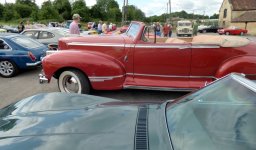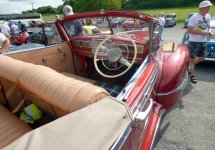You are using an out of date browser. It may not display this or other websites correctly.
You should upgrade or use an alternative browser.
You should upgrade or use an alternative browser.
Right hand drive C5
- Thread starter ZeroX
- Start date
Dorsetsteve
Well-known user
A bit like when I get in my van on a Monday morning, stop to get diesel and realise the fuel flap is on the other side…Like everyone else is saying , you will adapt and soon be second nature . As Antijam said , getting in the wrong door is the big mistake when your brain is on auto pilot and makes you feel a real `tit` at the petrol station !
Nassau65
CCCUK Member
That’s why I like the older type “yanks” the fuel filler was always behind the rear license plate. Just pull it downwards and the it was. No remembering left or right side.A bit like when I get in my van on a Monday morning, stop to get diesel and realise the fuel flap is on the other side…
Roscobbc
Moderator
It was always 'amusing' if driving my C3 (or any LHD American car) through the 'old' Dartford tunnel toll booths if driving single handed. Typically in a RHD car you would 'throw' your money from the drivers window at the large collection 'bucket' and the auto-count mechanism would could let and you pass (untill some of the coins were dodgy). Aiming and actually managing to hit the 'bucket' from the drivers side of a LHD vehicle was certainly challenging (as was trying to shuffle over to the passenger seat to lob the change in to the 'bucket' without it going all over the place!. It was far simpler to apply parking brake, put transmission in park/neutral, remove seat belt, open door, get out of the drivers side of the car walk around the front of your car and place the money in the 'bucket' (or the operative in the kiosk during earlier years.
Of course this could often significantly delay traffic flow and by the time you got back in the car, belted-up, selected drive/1st gear there would be a several hundred yard gap in the traffic in front........and the perfect oportunity to 'lay down a little rubber'!
Of course this could often significantly delay traffic flow and by the time you got back in the car, belted-up, selected drive/1st gear there would be a several hundred yard gap in the traffic in front........and the perfect oportunity to 'lay down a little rubber'!
Roscobbc
Moderator
Always a great excuse to 'gun' the engine and catch up with buddies if in a convoy of similar cars!Many fond memories of doing that, and getting dirty looks from the drivers stuck behind me for a few extra seconds
antijam
CCCUK Member
The toll booths are always the classic problem for UK drivers abroad travelling without a passenger. We owned a house in France for many years and if I didn't have my wife with me (or she was asleep) I quickly perfected the 'toll booth trot'. In the latter years the télépéage system was introduced whereby you purchased a transponder (in our case from Liber-t ) that you stuck on the windscreen behind the rear view mirror and as you approached automatically raised the toll barrier. This worked on the whole french Autoroute system although there was always the slight frisson of fear as you neared the barrier as to whether it was actually going to do the job .It was always 'amusing' if driving my C3 (or any LHD American car) through the 'old' Dartford tunnel toll booths if driving single handed. Typically in a RHD car you would 'throw' your money from the drivers window at the large collection 'bucket' and the auto-count mechanism would could let and you pass (untill some of the coins were dodgy). Aiming and actually managing to hit the 'bucket' from the drivers side of a LHD vehicle was certainly challenging (as was trying to shuffle over to the passenger seat to lob the change in to the 'bucket' without it going all over the place!. It was far simpler to apply parking brake, put transmission in park/neutral, remove seat belt, open door, get out of the drivers side of the car walk around the front of your car and place the money in the 'bucket' (or the operative in the kiosk during earlier years.
Of course this could often significantly delay traffic flow and by the time you got back in the car, belted-up, selected drive/1st gear there would be a several hundred yard gap in the traffic in front........and the perfect oportunity to 'lay down a little rubber'!
Last edited:
Chuffer
CCCUK Member
Having twin fuel tanks with a filler either side solved that problem . If I remember correctly early Jaguar XJ6`s had them .That’s why I like the older type “yanks” the fuel filler was always behind the rear license plate. Just pull it downwards and the it was. No remembering left or right side.
Nassau65
CCCUK Member
They looked pretty good with their twin chrome push off covers. My friends XJ had a hole in the RH tank, so he only used the left one . We pulled into the non self serve ( at the time) petrol station in park road Crouch End. Told the attendant LH tank and walked into the shop to pay etc. after a time there was shouting and arm waving outside. The attendant was filling the RH tank. All the petrol was running into the road. Road closed, fire brigade called. What a night. Once all sorted we still had to get the LH tank filled upHaving twin fuel tanks with a filler either side solved that problem . If I remember correctly early Jaguar XJ6`s had them .
Chuffer
CCCUK Member
Ooops !They looked pretty good with their twin chrome push off covers. My friends XJ had a hole in the RH tank, so he only used the left one . We pulled into the non self serve ( at the time) petrol station in park road Crouch End. Told the attendant LH tank and walked into the shop to pay etc. after a time there was shouting and arm waving outside. The attendant was filling the RH tank. All the petrol was running into the road. Road closed, fire brigade called. What a night. Once all sorted we still had to get the LH tank filled up
Roscobbc
Moderator
Very late 60's ('68/'69 perhaps) as a teenager I bought my first Jag - a 1960 Mk9 that was (then) seemingly in really superb condition having formerly been a chauffer driven company car which I bought with 50K miles. Twin tanks - the easiest and logical cone to use was the driver side. One Saturday evening 4 or 5 of us decided to split the non-insignificant fuel costs and go to Santa Pod the following day. To save time on the Saturday night we took the Jag down the local garage, 'brimmed' the drivers side tank, then repeated with the passenger side tank...........only to come back to the car after paying to see it all pouring out of the passenger side tank on to the garage forecourt.............just shows you how poor/non-existent rust and corrosion protection was on older vehicles. Ten year old cars were old bangers back then........today at they are barely half way through their useful 'life-cycles'!Ooops !
antijam
CCCUK Member
Went down to the Cross Hands breakfast meet today and parked next to a gigantic Hudson Commodore straight eight.......

An interesting and unusual car, I'd guess c.1947 ?.......and surprise, surprise - RHD !

Apparently a South African car. I gather the owner is considering selling, so if you're prepared to accept a little less performance than a C5.......


An interesting and unusual car, I'd guess c.1947 ?.......and surprise, surprise - RHD !

Apparently a South African car. I gather the owner is considering selling, so if you're prepared to accept a little less performance than a C5.......
Roscobbc
Moderator
Hudson straight eight 4/4.2 litre sidevalve engine was a great piece of kit. In the early 50's it dominated the stock racing classes. Here in the specialist high-end UK cars like the Railton and Brough Superior used the Hudson chassis and engines (with traditional and comparitively lightweight coachwork - as compared with Hudson's OEM steel bodies) and fast engine for the Metropolitan Police as Flying Squad vehicles.
Chuffer
CCCUK Member
Yep ! And they then ended up on the Banger Racing Circuits such as Brafield not far from me . Old Jags were always popular due their shear size and could take more punishment before being wrecked . My first car was a 1967 Vauxhall HB Viva that I bought off one my of rugby team mates . It steadily decomposed before my eyes and by the time it was 10 years old the bonnet hinges collapsed through the rotten inner wings !!Very late 60's ('68/'69 perhaps) as a teenager I bought my first Jag - a 1960 Mk9 that was (then) seemingly in really superb condition having formerly been a chauffer driven company car which I bought with 50K miles. Twin tanks - the easiest and logical cone to use was the driver side. One Saturday evening 4 or 5 of us decided to split the non-insignificant fuel costs and go to Santa Pod the following day. To save time on the Saturday night we took the Jag down the local garage, 'brimmed' the drivers side tank, then repeated with the passenger side tank...........only to come back to the car after paying to see it all pouring out of the passenger side tank on to the garage forecourt.............just shows you how poor/non-existent rust and corrosion protection was on older vehicles. Ten year old cars were old bangers back then........today at they are barely half way through their useful 'life-cycles'!
Chuffer
CCCUK Member
Remember the Lancia debacle ? Going rusty as left the show rooms !!A client had an early 70’s 246GTS ( flares and chairs) Dino. This was 1977 and the car was probably a 72/73. It was rotten as a pear, holes everywhere. No rustproofing in those days plus cheap Italian steel didn’t help.
Nassau65
CCCUK Member
That’s why Lancia’s are rare today, most rusted away before your very eyes. Shame as some of them were quite nice .Remember the Lancia debacle ? Going rusty as left the show rooms !!
Nassau65
CCCUK Member
We’ve had a few springs go on our Fords over the last couple of years. Yes, they certainly seem to be thinner these days. Got a set of mid year springs that I’ve had for 30+ years. They are heavy mothers.Talking to a garage hand the other day and I asked if rust was still a failure problem on modern cars. "No" he said "these days it's road-springs."
Cheap manufacture combined with our endemic pothole problem.
